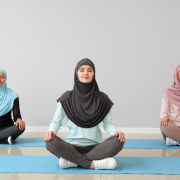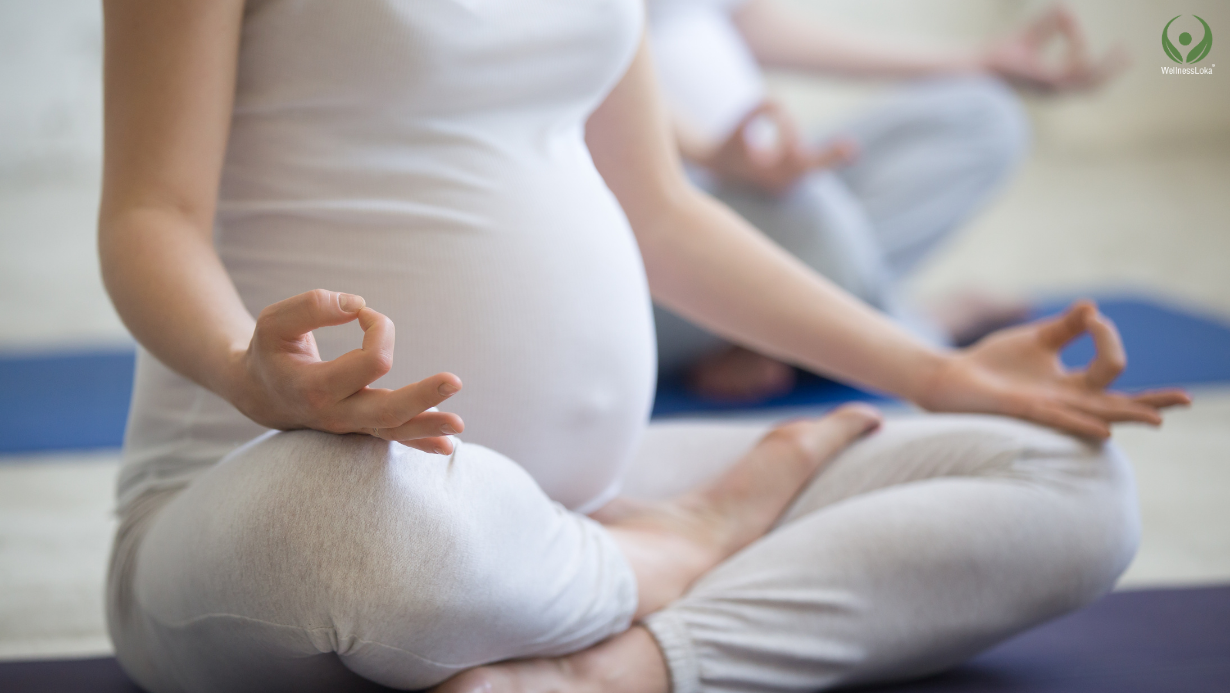Yoga And Its Benefits During Ramadan

Ramzaan is considered as the holy month with happiness ,devotion and fasting. The aim of fasting is not only devotion but also weight management, cell regeneration and detoxification of the body. The motive of fasting is to stay young and healthy. Along with fasting yoga practice also helps to keep healthy during the ramzaan days. Mild asanas , pranayama like breathing exercises help in to detoxify the body.
Types of yoga and its uses
-
Yoga for mindfulness
Mindful Yoga or Mindfulness Yoga combines Buddhist-style mindfulness practice with yoga as exercise to provide a means of exercise that is also meditative and useful for reducing stress during these times.
Uses
- Improves physical health.
- Improves mental health.
- Gain insight into our own feelings and thoughts.
- Have greater clarity in decision making as well as productivity and results in improved creativity.
- Have more gratitude and spontaneity in life.
-
Yoga for detoxification
Detoxification is process in which toxins expelled or removed from the body. Fasting during ramzan days plays a significant role in removing the toxins and impurities from the body. In the same way yoga also have a role to remove the toxins through various techniques like breathing exercises, asanas etc.
Uses
- Cleanse the body and mind
- Relax mentally and physically
- Maintains a balanced metabolism
- Improves sleep quality and quality of life
-
Yoga for sleep
Yoga may help to put your body in a calm state, known as the relaxation response. This is the opposite of the fight-or-flight response. Doing calming yoga poses may help you to relax and enter a lower state of arousal. This may cause you to have lower blood pressure and lower amounts of the stress hormone cortisol. A routine may help to alleviate stress-related concerns such as weight gain, anxiety, and insomnia.
Uses
- Alleviates insomnia
- Improves sleep quality and quality of life
- Promotes relaxation
- Reduce stress and anxiety
-
Yoga for weight management
Yoga is the art of taming your mind and controlling your conscious senses to be active all day long. Practicing yoga makes you more conscious to the whispers of your body. As you become more conscious you become more aware of the food you intake, the calories, the diet you follow etc. along with exercises. it is also important to keep a track on your calorie intake and food habits, for proper weight loss. Thus yoga contributes a major part to your endeavour of weight loss.
Uses
Yoga is a promising way to help with behavioral change, weight loss, and maintenance by burning calories, heightening mindfulness, and reducing stress. These factors may help you to reduce food intake and become aware of the effects of overeating.
Types of asanas and its benefits during ramzan
The asanas or postures which helps to maintain weight , cell regeneration and detoxification of the body.
-
Dhanurasana

Dhanurasana also known as bow pose. It helps in strengthening the spine and helps to improve our metabolism. Relax mentally and physically.
- Lie flat on your stomach with your arms by your sides.
- Bend your knees and bring your heels as close as you can to your buttocks.
- Reach back with your hands and grab your ankles. Keep your palms facing upward.
- Inhale deeply and lift your chest off the ground. Simultaneously, kick your legs back and up, lifting your thighs away from the floor.
- Your body weight should be resting on your abdomen.
- Keep your gaze forward and hold the posture for 15-30 seconds, breathing deeply.
- To release, exhale and gently lower your chest and legs back to the floor. Release your ankles and relax.
Remember to practice within your limits, and if you have any back or neck injuries, it’s best to consult a yoga instructor before attempting this pose. Additionally, pregnant women and individuals with high blood pressure should avoid this pose.
-
Bujangasana

Bujangasana also known as cobra pose. It gives a nice streching to the spine and will help to get good sleep. This asana also helps in relieving headache and migraine. Here’s how to practice Bhujangasana:
-
Sethubandasana

Sethubandasana also known as bridge pose which helps to relieve from back ache and body pain.
-
Pranayama or breathing exercises

Pranayama is a Sanskrit term that refers to the practice of breath control in yoga. It consists of various techniques to regulate and control the breath, which in turn influences the flow of vital energy (prana) in the body. Pranayama exercises are an integral part of yoga practice and can have profound effects on both physical and mental well-being. Here are a few common pranayama techniques:
- Deep Breathing (Dirga Pranayama): This involves deep inhalation and exhalation, filling the lungs completely with each breath. It helps to increase lung capacity, relax the body, and calm the mind.
- Ujjayi Pranayama: Also known as “Ocean Breath” or “Victorious Breath,” Ujjayi Pranayama involves constricting the back of the throat slightly while breathing, creating a soft whispering sound. It helps to regulate the breath, build internal heat, and increase concentration.
- Nadi Shodhana (Alternate Nostril Breathing): Nadi Shodhana involves alternating the breath between the left and right nostrils using the fingers to block one nostril at a time. This technique helps to balance the flow of energy in the body, calm the mind, and reduce stress.
- Kapalabhati Pranayama (Skull Shining Breath): Kapalabhati involves rapid, forceful exhalations followed by passive inhalations. It helps to purify the respiratory system, increase oxygen supply to the brain, and energize the body.
- Bhramari Pranayama (Bee Breath): Bhramari involves making a gentle humming sound while exhaling, similar to the buzzing of a bee. It has a soothing effect on the nervous system, reduces anxiety, and promotes relaxation.
- Sitali Pranayama (Cooling Breath): Sitali involves inhaling through a rolled tongue or pursed lips, creating a cooling sensation in the body. It helps to reduce body heat, calm the mind, and alleviate thirst.
Practicing pranayama regularly can bring about numerous benefits, including improved respiratory function, increased oxygenation, reduced stress, enhanced mental clarity, and heightened self-awareness. It’s essential to learn pranayama techniques from a qualified yoga instructor and practice them mindfully, paying attention to your breath and its effects on the body and mind.
How yoga helps in detox during Ramzan
Can yoga for mindfulness balance mind and body during ramzan.
Yes, practicing yoga for mindfulness can indeed help balance the mind and body during Ramadan. Here’s how:
- Mindful Awareness: Yoga encourages mindfulness, which involves being fully present and aware of your thoughts, emotions, and sensations in the present moment. Mindfulness practices, such as mindful breathing and mindful movement in yoga, can help individuals develop greater self-awareness and conscious attention to their experiences during Ramadan, including sensations of hunger, thirst, and fatigue.
- Stress Reduction: Mindfulness-based yoga practices, such as gentle yoga sequences, breathing exercises, and meditation, have been shown to reduce stress levels and promote relaxation. This can be particularly beneficial during Ramadan when individuals may experience increased stress due to fasting, changes in routine, and other factors.
- Emotional Balance: Yoga for mindfulness cultivates emotional resilience and balance by fostering acceptance, compassion, and equanimity towards oneself and others. This can be valuable during Ramadan, as individuals may encounter various emotions, including patience, gratitude, and self-reflection, while fasting and engaging in spiritual practices.
- Physical Well-being: Yoga promotes physical well-being by stretching and strengthening the body, improving circulation, and enhancing flexibility and balance. Practicing yoga during Ramadan can help maintain overall health and vitality, support the body’s detoxification processes, and alleviate any discomfort or stiffness that may arise from fasting.
- Connection to Spirituality: Yoga and mindfulness practices can deepen one’s connection to spirituality and inner peace, complementing the spiritual aspects of Ramadan. Through yoga, individuals can explore their inner landscape, connect with their deeper selves, and cultivate a sense of spiritual fulfillment and alignment with their values and intentions during the holy month.
- Gratitude and Contentment: Mindfulness-based yoga practices encourage gratitude, contentment, and acceptance of the present moment, fostering a positive mindset and outlook. This can help individuals appreciate the blessings of Ramadan, focus on what truly matters, and cultivate a sense of inner peace and fulfillment despite the challenges of fasting.
By incorporating yoga for mindfulness into their Ramadan routine, individuals can nurture their mind-body connection, enhance their spiritual practice, and cultivate greater well-being, balance, and resilience throughout the holy month. It’s essential to approach yoga practice with gentleness, compassion, and self-awareness, honoring the body’s needs and limitations, especially during fasting hours. Consulting with a qualified yoga instructor or healthcare provider can provide guidance on suitable yoga practices during Ramadan and ensure a safe and beneficial experience.
Precautions while doing yoga during Ramzan
WellnessLoka is established with the aim of making the world a healthier and a happier place. With a carefully curated selection of 3500+ wellness retreats in collaboration with 250 trusted gurus and properties, we simplify the process of discovering and booking authentic Ayurveda and Yoga experiences. Our team of experienced wellness consultants and doctors are here to assist you choose the retreat that best aligns with your goals and budget. As your dedicated representative in Kerala, we prioritise your interests, ensuring peace of mind during your stay. We maintain long-term partnerships with resorts, allowing us to secure the best prices for you!
Visit www.wellnessloka.com to explore the world of authentic wellness retreats.




